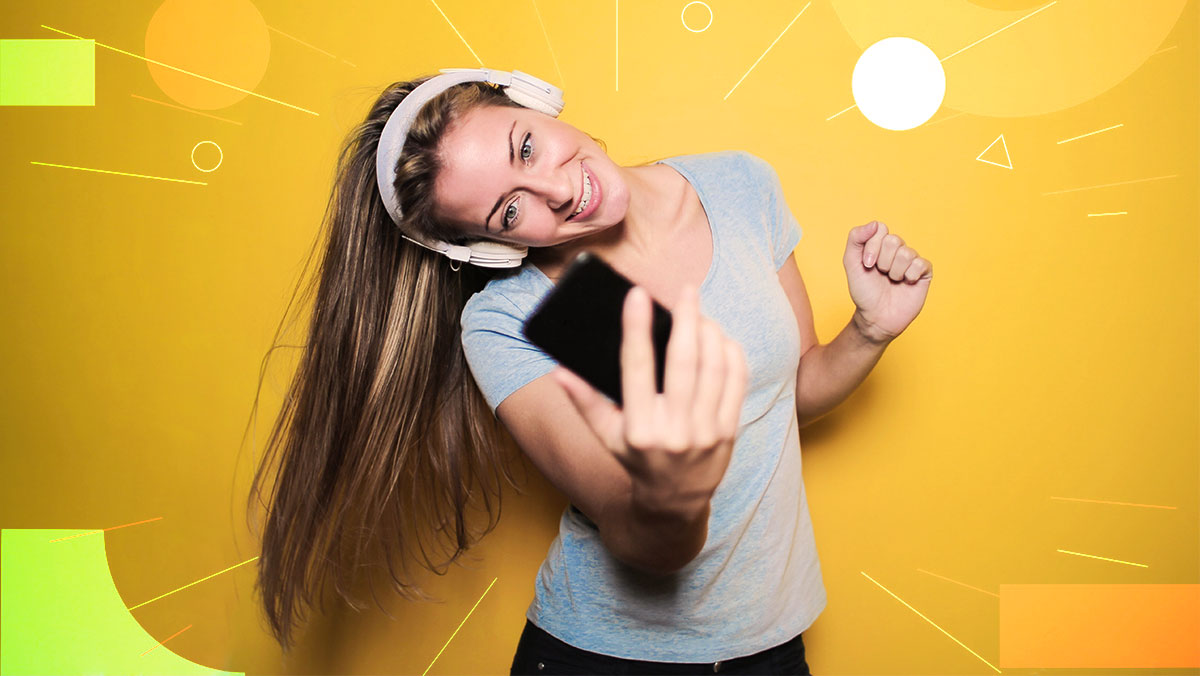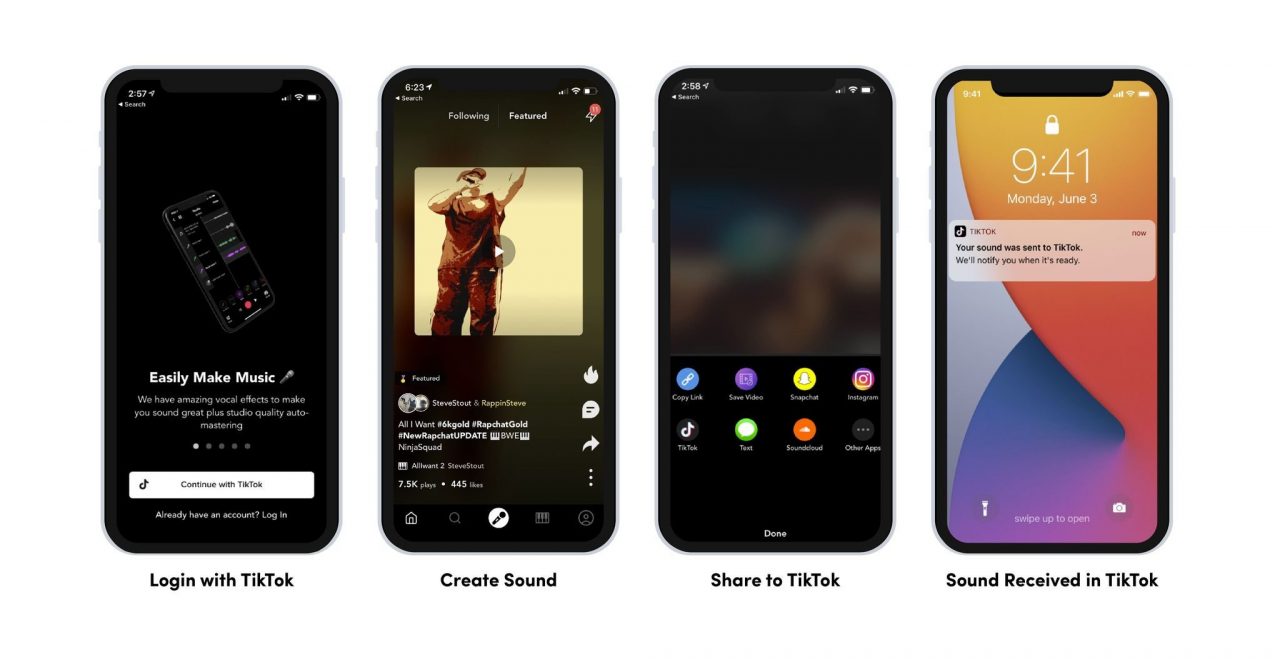
When it comes to sound, sharing is caring. From record-breaking Billboard tracks to underground hits, from movie dialog to custom clips, from jingles to bleeps and blips, adding soundbites to social media posts has never been more streamlined. Today, all of the major players, namely TikTok, Instagram, and Snapchat, have developed nearly identical audio-sharing features to one another. This wasn’t always the case. Catalyzed by competition, this homogenization took place over a period of several platform iterations.
Photo-sharing platforms
In the dawn of social media, Facebook was founded for finding friends. Then, Twitter became the place where words ruled the world (as “the SMS of the Internet”). So, when Instagram launched in 2010 and debuted as a photo-sharing platform, it took a new approach by attracting artists, photographers, and graphic designers rather than just bloggers and buddies.
With a primarily visual user experience, the silent era of this social media platform was limited to photos – taking, uploading, liking, and sharing. The focus was first and foremost on filters and hashtags. It wasn’t until 2013 that video posts were introduced, which also meant that users could finally hear their timeline (as well as an abundance of ads).
Story-sharing platforms
That very same year, Snapchat introduced Stories. These so-called “Stories”, much like the success of Snaps, functioned more as fleeting content collections. They could be photos, screenshots, videos, or any mix of media. Unlike the semi-permanence of the Instagram grid, there was only a limited time to watch (or listen) to what your friends and followers were up to. This created an increase in demand for a supply of ephemeral experiences (with a 24-hour expiration date). With FOMO afoot, it was no surprise that Instagram revealed their own version of Stories another three years later in 2016 (with Facebook following suit the next year) to compete with this fan-favorite format. As Stories took center stage, video was poised to become the new platform leader.
Video-sharing platforms
By 2017, TikTok changed everything as it made its international debut as a video-sharing platform. With short-form skits a la the late (but great) Vine, and a viewership that would someday rival YouTube, photo-sharing was quickly becoming a thing of the past. Imitation is certainly the finest form of flattery, as ByteDance’s trendy tool for creators and entertainers paved the way for the latest “clone” by Instagram: Reels. With “Remix This Reel” at the touch of a button, the benefit of competition to consumers was a refined method for mixing and matching music with videos.
Music-sharing platforms
“Music is TikTok’s universal language”, according to Year on TikTok 2020. In this year’s retrospective, “It’s the glue that connects TikTok’s disparate threads, providing a throughline between individuals and communities who bring their own spin to the latest trend.” A great score may not be able to save a bad film, but great music can boost the views of a vertical video.
As the world watched more and more on their smartphones, vloggers and the like naturally began streaming Spotify in the background or unwittingly using songs illegally to score the soundtrack of daily life. Whichever the case, this lead to flags for copyright infringement, which was not very conducive to artistic creation and development. Thankfully, recent upgrades such as Music on Instagram Stories mean that creators can worry less about legal ramifications and more about recording content. Discovering new music and artists can occur within a single framework rather than exiting one app to go to another, eliminating the extra step of seeking streaming platforms like SoundCloud, Bandcamp, or Tidal. This upgrade is a promising start as they continue to ink more deals with the majors.
Taylor Swift is celebrating 4.6 billion views from the #swifttok trend. As for minor acts, many are having their moment in the spotlight or even breaking through to the big leagues. In the last year alone, the amount of songs that have surpassed one billion views has grown triple-fold. The viral nature of the algorithm leaves everyone on their toes, as an unexpected song can takeoff overnight all because of a dance.
Sound-sharing platforms
The paradigm shift from photo-sharing to video-sharing yielded a new unofficial platform: sound-sharing. More than just music, being able to search for any sound – beyond simply songs – opened up an entirely new world of possibilities: movie quotes, animal noises, source audio, SFX, and more. For the first time on social media, audio gained the ability to be decoupled from its source video and have a life of its own. Not only that, these audio files are featured like filters in that they are attributed to their authors (although this could be greatly improved by AI). You no longer need to be a musician to share sounds with the world.
With a catalog of verified artists and amateur users alike, memes became musical. Not to be confused with memes about music, rather than simply recontextualizing an image like in a typical meme, videos are now being used to recontextualize sounds. In this case, the music is the constant, and the footage is the variable. Perhaps one of the most notable and inescapable examples of this is the phenomenon of “Oh No!” The pitched-up chord progression builds the perfect tension for synchronizing any disaster footage when the hook drops.
Shareable sonic branding
TikTok is championing the idea of centering campaigns around sonic branding. While they illustrate McDonald’s as an example in the below graphic, there’s another surprising brand that recently made a splash with their sound.
The Home Depot became an unsuspected sensation after their branded backtrack (developed shortly after accusations of a scandalous soundalike) was introduced to the cultural zeitgeist. Fans began choreographing dances to this guitar-driven riff, but it didn’t stop there. DIY enthusiasts used the beat on TikTok as a soundtrack for their shopping, punctuated by the percussive anvil clanks.
O’Reilly’s Auto Parts is another brand leaning into sonic branding. Their first TikTok is a mashup of their jingle and the “Oh No! Our Table! It’s Broken!” meme. Other users join in on the fun as well. One user mashes up the iconic “Ow!” at the end of the mnemonic with other singable slogans including Folgers Coffee, Empire Today, and Farmers Insurance.
In today’s tech-savvy world, earcons are also having their moment. For example, this Face ID trend couples @Brittany’s laugh with the Apple Pay confirmation UX sound. In this template, lookalikes imitate the likeness of celebrities and stars to “unlock their iPhones”, and the signature success sound chimes in after they strike a pose.
The key takeaway for brands is that we are undeniably entering a sound-centric era. Whether the strategy is to simply upload existing jingles and other soundmarks, or to commission custom compositions for the medium, sharing sonic branding with the world enables your audience to engage in a whole new way. User-generated audio branding is a positive way for the audience to participate in audio branding, which can raise overall brand awareness and perception.
Future platform predictions
This is only the beginning of shareable sonic branding. If the sound stats teach us anything, it should be that investing in sound-on campaigns yields an impressive ROI. “For brands to resonate on TikTok, they need to build holistically with audio as a primary creative driver”, the report reads. Holism is the operative word here.
To create an audio identity in today’s world means that we really need to consider where users are experiencing audio, and how that environment is rapidly changing. Right now, that’s on TikTok, Instagram, and YouTube. In the future, we could soon find ourselves experiencing sonic branding in a much more virtual platform: the musical metaverse.
Cover image source: Andrea Piacquadio (& Tik Tok)

